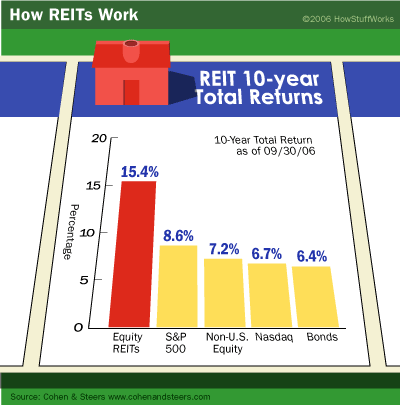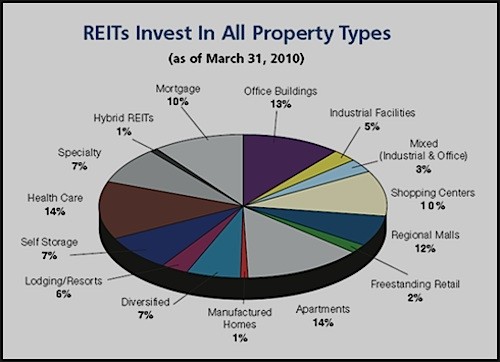Investing in REITs
Post on: 16 Июнь, 2015 No Comment

How do I invest in a REIT?
An individual may invest in a publicly traded REIT, which is listed on a major stock exchange, by purchasing shares through a securities dealer. As with other publicly traded securities, investors may purchase common stock, preferred stock or debt securities. An investor can enlist the services of a broker, investment advisor or financial planner to help analyze his or her financial objectives. These professionals may be able to recommend appropriate REIT investments for the investor. An investor may also contact a REIT directly for a copy of the company’s annual report, prospectus and other financial information. Much of this information is available on a company’s website. REIT.com maintains a list of most publicly traded REITs and provides links to their respective websites, as well as a searchable directory of companies by name, property type, location, stock exchange or type of REIT. Many financial websites and local libraries offer a wide range of investment research and information on REITs.
Another alternative is to diversify your investment further by buying shares in a REIT mutual fund or exchange-traded fund. A list of such funds also is available on REIT.com. Investors can compare and evaluate the performance of funds through information sources such as Morningstar®, Inc. These sources can offer detailed information on funds’ past performance, current portfolio holdings and costs of investing.
What should I look for when investing in a REIT?
The market usually rewards companies that demonstrate consistent earnings and dividend growth with higher price-earnings multiples. Thus, investors should look for REITs and publicly traded real estate companies with the following characteristics:
- A demonstrated ability to increase earnings in a reliable manner. For example, look for companies with properties in which rents are below current market levels. Such properties provide upside potential in equilibrium markets and downside protection when economic growth slows.
- Management teams able to quickly and effectively reinvest available cash flow. The ability to consistently complete new projects on time and within budget. Creative management teams with sound strategies for developing new revenue opportunities.
- Strong operating characteristics, including effective corporate governance procedures, conservative leverage, accepted accounting practices, strong tenant relationships and a clearly defined operating strategy for succeeding in competitive markets.
How do REITs measure earnings?
Like the rest of corporate America, the REIT industry uses net income as defined under Generally Accepted Accounting Principles (GAAP) as the primary operating performance measure.
The REIT industry also uses funds from operations (FFO) as a supplemental measure of a REIT’s operating performance. NAREIT defines FFO as net income (computed in accordance with GAAP) excluding gains or losses from sales of most property and depreciation of real estate. When real estate companies use FFO in public releases or SEC filings, the law requires them to reconcile FFO to GAAP net income.
Most real estate professionals as well as investors believe that commercial real estate maintains residual value to a much greater extent than machinery, computers or other personal property. Therefore, they view the depreciation measure used to arrive at GAAP net income as generally overstating the economic depreciation of REIT property assets and the actual cost to maintain and replace these assets over time, which may in fact be appreciating. Thus, FFO excludes real estate depreciation charges from periodic operating performance. Many securities analysts judge a REIT’s performance according to its adjusted FFO (AFFO), thereby deducting certain recurring capital expenses from FFO.
NAREIT’s April 2002 white paper on FFO discusses the definition in detail, advises REITs to adopt certain computational and disclosure practices and recommends that REITs disclose additional information about other financial calculations such as details on capital expenditures. Access the full white paper and additional information on financial performance and reporting standards in our Financial Standards & Reporting section.
How do investors gauge a REIT’s ability to pay dividends?
Many investors often look at the payout ratio as the measure of a REIT’s ability to pay its current dividends. Because real estate depreciation is a large non-cash expense that likely overstates any decline in property values, dividend per share divided by net income per share likewise understates a REIT’s ability to sustain dividend payments. Therefore, the payout ratio, calculated as dividend per share divided by funds from operations (FFO) per share, or as dividend per share divided by adjusted funds from operations (AFFO) per share, is used by many as a more accurate measure of the REIT’s ability to pay dividends.
What Factors Contribute to REIT Earnings?
Growth in earnings typically comes from several sources, including higher revenues, lower costs and new business opportunities. The most immediate sources of revenue growth are higher rates of building occupancy and increasing rents. As long as the demand for new properties remains well balanced with the available supply, market rents tend to rise as the economy expands and increases demand for space. Low occupancy rates in underutilized buildings can be increased when skilled owners upgrade facilities, enhance building services and more effectively market properties to new types of tenants. Property acquisition and development programs also create growth opportunities, provided the economic returns from these investments exceed the cost of financing. Like other public companies, REITs and publicly traded real estate companies also increase earnings by improving operating efficiency and taking advantage of new business opportunities.

The REIT Modernization Act (RMA), which took effect on Jan. 1, 2001, provides REITs with other opportunities to increase earnings. Prior to the enactment of the RMA, REITs were limited to providing only those services that were long accepted as being usual and customary landlord services, and were restricted from offering more advanced services provided by other landlords. The RMA allows REITs to own taxable subsidiaries that can provide the competitive services that many of today’s tenants desire, as well as to provide services like real estate asset management for other investors.
How Are REIT Stocks Valued?
Like all companies whose stocks are publicly traded, REIT shares are priced by the market throughout the trading day. To assess the investment value of REIT shares, typical analysis involves one or more of the following criteria:
- Anticipated growth in earnings per share
- Anticipated total return from the stock, estimated from the expected price change and the prevailing dividend yield
- Current dividend yields relative to other yield-oriented investments (e.g. bonds, utility stocks and other high-income investments)
- Dividend payout ratios as a percent of REIT FFO (see above for discussion of FFO and payout ratios)
- Management quality and corporate structure
- Underlying asset values of the real estate and/or mortgages, and other assets
What Real Estate Fundamentals Should I Consider Before Investing?
REIT investors often compare current stock prices to the net asset value (NAV) of a company’s assets. NAV is the per share measure of the market value of a company’s net assets. At times, the stock price of a REIT may be more or less than its NAV. Investors should understand some of the fundamental factors that influence the value of a REIT’s real estate holdings. One critical factor is how well balanced is the supply of new buildings with the demand for new space. When construction adds new space into a market more rapidly than it can be absorbed, building vacancy rates increase, rents can weaken and property values decline, thereby depressing net asset values.
In a strong economy, growth in employment, capital investment and household spending increase the demand for new office buildings, apartments, industrial facilities and retail stores. Population growth also boosts the demand for apartments. However, the economy is not always equally strong in all geographic regions, and economic growth may not increase the demand for all property types at the same time. Thus, investors should compare the locations of properties of different companies with the relative strength or weakness of real estate markets in those locations.
Information on company properties is available at their websites, and links to these sites are available at REIT.com. Information on local and regional real estate markets is available in the financial press or at research sites on the Internet such as www.ppr.info or www.cbre-ea.com .
What Role Do REITs Play in Retirement Savings Plans?
As the baby boom generation moves into its retirement years, a progressively larger segment of our society will come to depend on retirement plans for their income. Additionally, this population of retirees will be living longer. Unlike their parents and grandparents, today’s 65-year-old retirees will have to live on their retirement benefits for an additional 20, 30 or even more years.
In the United States, the median life expectancy of a 65-year-old man and woman is 85 and 88, respectively. However, because the median represents the exact mid-point of the group’s age range, half of this population will live longer, often much longer, than the median life expectancy.
The growing population of retirees who may spend a third or more of their lifespan in their retirement years is creating new challenges for retirement plan sponsors. Plan sponsors today must select investments that deliver a consistently high level of income to meet the current needs of the expanding crop of baby boom generation retirees, but also generate portfolio growth to ensure that the needs of retirees are met three decades in the future, and to offset the effects of inflation in the process.
Many plans are turning to increased allocations to real estate, including REITs, for solutions to these problems. The requirement that REITs pass at least 90 percent of their taxable income through to shareholders in the form of dividends makes them a strong income generating investment. However, as stocks, REITs also provide the opportunity for capital appreciation. This combination of investment characteristics makes them effective in extending the lives of retirement portfolios.
More Frequently Asked Questions About REITs:














